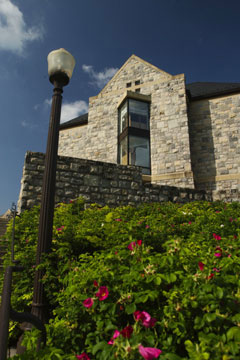 |
The name "Virginia Tech" evokes many images: Lane Stadium full of cheering crowds; the War Memorial at night; and especially the Drill Field, bordered by dignified gray stone buildings that seem entirely fitting.
The appropriateness of Virginia Tech's architecture is no accident. In the early 20th century, Tech's presidents and their architects battled against what one of them called the "poverty-stricken factory" look in order to give the school the appearance of a great university. Their vision was later forgotten, but at the end of the century, a new generation picked up the banner, adding to the campus some of its finest buildings.
The Virginia Tech look boils down to a simple formula: Hokie Stone + Gothic. The first campus buildings, built in the 1870s and 1880s, were brick, and they were detailed in the Italianate and Second Empire styles of the Victorian era. It so happens that cotton mills and shoe factories were built of the same material and in the same styles. The similarity reinforced a perception of Tech as a second-rate vocational school.
|
|
The first efforts to find an alternative came during the administration of President John McBryde (1891 to 1907). In 1899, a group of alumni hired Richmond architect W.F. West to design a YMCA for the campus. West's Romanesque-inspired building--today's Performing Arts Center--was the first flagship building constructed of rough limestone quarried on campus. President McBryde and his faculty became converts to what they called "our native limestone." The stone was used for the 1905 Chapel (now gone) and for Price Hall, built in 1906-1907 at the far end of a marshy low ground that would evolve into the Drill Field. By the 1920s and 1930s, the variegated gray stone--dubbed Hokie Stone--had acquired its present appearance, and it was used for all major building projects.
The Gothic part of the formula also dates to the McBryde years. "Gothic" is the name given to the great medieval cathedrals with their distinctive lancet arches and vertical composition. Harry Potter's alma mater Hogwarts is an over-the-top example of the style. Cambridge and Oxford were originally Gothic in character, which made the style a natural choice for prestigious American institutions such as West Point, Princeton, and the University of Chicago. A leading proponent of Collegiate Gothic was Boston architect Ralph Adams Cram, an acquaintance of McBryde who visited the Tech campus and advised McBryde on its improvement. The 1905 Chapel was Tech's first Gothic (technically, Gothic Revival) building, followed by the 1914 McBryde Building, which stood on the site of the present McBryde Hall.
The McBryde Building, designed by the Richmond firm of Carneal & Johnston, set the standard at Tech for a generation. The Hokie Stone building featured a three-story entry tower with battlements, a projecting oriel window, and a lancet-arched passageway to an inner courtyard. The McBryde Building "marked the beginning of a long and happy association" between Virginia Tech and Carneal & Johnston, according to Tech historian Lyle Kinnear. The firm had been recommended to Tech by Cram, and one of its two principals, J. Ambler Johnston, was a Tech alumnus.
|
 |
 |
The McBryde Building was the first of its kind in other ways. Carneal & Johnston adapted its central tower motif for later buildings such as Memorial Gymnasium, completed in 1926, and the massive Burrus Hall, built in 1934-1936. The embryonic McBryde courtyard was expanded to create quadrangles for the academic buildings and residential halls constructed to the south of the Drill Field. Although the McBryde Building no longer stands, sculptures from its facade showing students engaged in wood and metal crafting were saved and installed in the lobby of McBryde Hall.
By the mid-20th century, the core campus had acquired its present character, with Gothic-inspired Hokie Stone buildings ranged around the Drill Field. But as the dreams of McBryde, Eggleston, and their contemporaries came to fruition, the profession of architecture turned away from historical styles and embraced modernism. New construction at the edges of campus in the 1960s and early 1970s substituted concrete and brick for native stone. Modernist buildings such as Cassell Coliseum or Derring Hall might have been built anywhere, so disconnected were they from Virginia Tech tradition.
At the end of the 20th century, architects rediscovered history. At Virginia Tech, the philosophy of contextualism--the idea that architecture should respect and reinforce tradition--guided infill construction at the campus core. Most recent buildings reference the Hokie Stone Gothic style. Towers, cast-stone shields, and projecting bay windows accent the facades of McComas Hall and the Student Services Building on Washington Street. The graceful Mall-spanning Gothic bridge of Torgersen Hall frames the formal entrance to campus in Hokie Stone.
|
| Presidents such as McBryde and Eggleston saw architecture as a way to build an identity for the struggling young school. Hokie Stone Gothic provided an alternative to the brick classicism standard in Virginia school architecture of the 19th century, most notably at Tech's rival for funding and prestige, the University of Virginia. The Gothic style affirmed Virginia Polytechnic Institute as an heir of the universities of old, a place of academic excellence; and native limestone--as one early observer put it--made Tech's new architecture "a product of Virginia soils and ingenuity from beginning to end." Today, architecture is as important as ever in defining the Virginia Tech experience. |
|